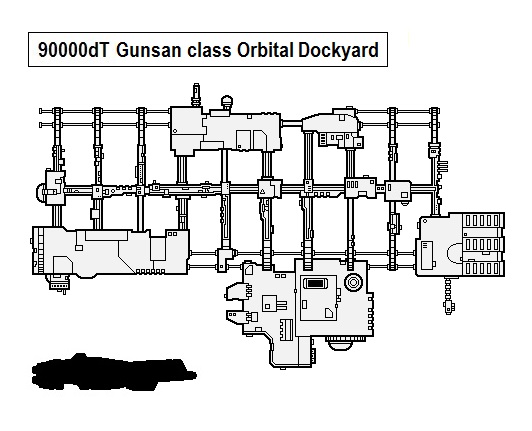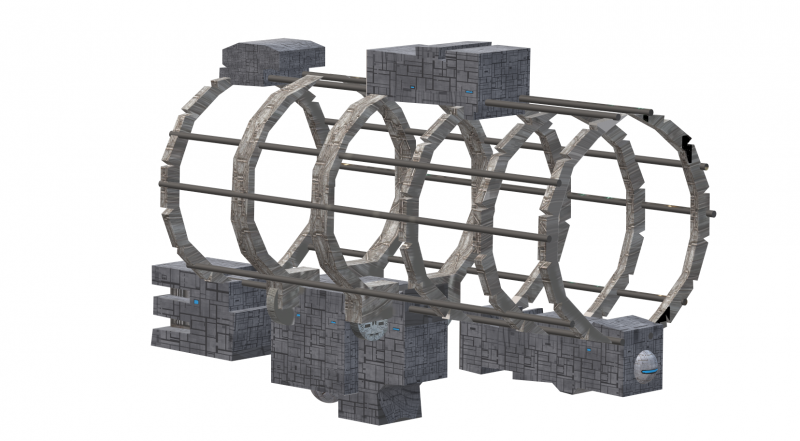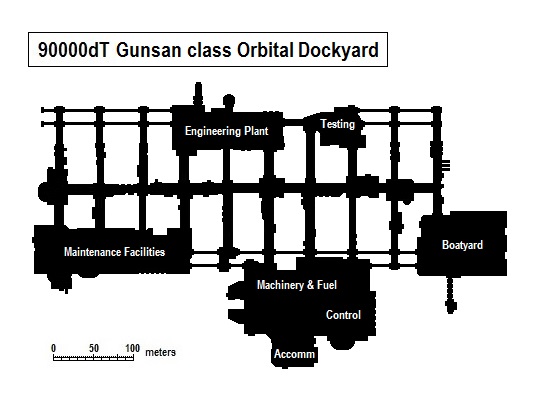Gunsan class Orbital Dockyard
| Gunsan class Orbital Dockyard | |
|---|---|
 Distant Fringe object. | |
| Type: JW Orbital Dockyard | |
| Category | BCS |
| Size | 90,000 Tons |
| Hull Configuration | Dispersed Structure Hull |
| Streamlining | Unstreamlined Hull |
| Tech Level | TL–11 |
| Engineering | |
| Computer | Model/5 |
| Jump | J-0 |
| Maneuver | 0.5 G |
| Armaments | |
| Hardpoints | |
| Accommodations | |
| Staterooms | 1,000 |
| Personnel | |
| Crew | 516 |
| Officers | 104 |
| Enlisted | 412 |
| High/Mid Passengers | 600 |
| Payload | |
| Cargo | 14,000 Tons |
| Fuel tank | Tons |
| Special features | 50,000t hangar |
| Construction | |
| Origin | Distant Fringe |
| Price | |
| Cost | MCr30,060.95 |
| Statistics | |
| Universal Ship Profile | WO–Q700152–000004–00000-0 |
| Images | |
| Blueprint | No |
| Illustration | Yes |
| Source | |
| Canon | Unpublished, fan design |
| Designer | Ade Stewart |
| Design System | High Guard |
| Era | 1105 |
| Reference | Fan: Ade Stewart |
The Gunsan class Orbital Dockyard is a TL–11 large Orbital Dockyard.
- Please also see AAB article: Ships of the Distant Fringe.
Description (Specifications)[edit]
The Orbital Dockyard is a large commercial orbital facility found within systems in the Distant Fringe region. It is classified as an Orbital Complex. Similar designs have been in use from the time the Distant Fringe was first settled.
Image Repository[edit]
- A Gunsan class Orbital Dockyard with an Olympian class Cruise Liner (silhouetted) alongside.

- Beside a Gunsan class Orbital Dockyard. As is common with this design, the factory components are located around the exterior of the construction cylinder according to the operators preferences.

General Description[edit]
The dockyard is constructed as a Dispersed Structure. The core of the station is the yard space, an empty cylinder surrounded by joined rings with an enclosed volume of approximately 1.3 million dTons. Sections within this cylinder are set aside as maintenance facilities, an engineering plant, and an equipment testing facility: each area has multiple hangars and sealed compartments. Individual dockyards contain the same basic elements but their layouts may vary considerably, depending on the needs and preferences of the operator.
The main section of the dockyard is a boxy structure built onto the exterior of the rings. It contains much of the heavy machinery, the operations control center, and the crew and passenger accommodations. An enclosed boatyard is set aside for the manufacture of smaller starships and smallcraft.
Each area of the dockyard can be accessed by transportation pods that follow trackways mounted on the interior of the yard rings. All sections of the yard can also be accessed by internal walkways, though many areas have no grav plates and some sections may not be pressurized.
The dockyard mounts x80 Heavy Repulsor units in bays spread over the interior of the yard space rings. These are used as construction tools, working in groups to maneuver and manipulate very large components.

A basic plan of the station indicating the general layout and positioning of major elements.
Basic Ship Characteristics[edit]
Following the Imperial Navy and IISS Universal Ship Profile and data, additional information is presented in the format shown here. The small craft factor indicates the number of squadrons (of ten craft) carried on the ship. Tonnage on the universal ship profile is shown in kilotons (thousands of tons) where necessary. [1]
| Basic Ship Characteristics [2] | ||
|---|---|---|
| No. | Category | Remarks |
| 1. | Tonnage | The Orbital Dockyard is constructed using a 90,000 dTon hull built in a dispersed structure configuration. The hull is unstreamlined and cannot survive entry into a planetary atmosphere.
|
| 2. | Crew | Total Crew Complement: 516
Accommodations:
Accessible areas of the hull are fitted with grav plates and inertial compensators and have full life support and environmental systems.
|
| 3. | Performance | The dockyard mounts a Maneuver half-drive, and a Power Plant-1, giving performance of 0.5-G acceleration (sufficient for orbital positioning only) and producing 900 Energy Points. The dockyard does not have an agility rating. The dedicated internal fuel tankage gives the power plant 4 weeks duration.
|
| 4. | Electronics | Adjacent to the bridge is a Model/5 Computer: the dockyard has x3 backup Model/5 Computers.
|
| 5. | Hardpoints | x900 hardpoints.
|
| 6. | Armament | The dockyard is unarmed. |
| 7. | Defenses | The hull is unarmored.
x80 100-Ton bays, mounting Repulsors. The Repulsors face inward and are used as construction tools, using gravitic forces to manipulate and maneuver large components. The dockyard is not fitted with screens or other passive defensive systems. |
| 8. | Craft | The dockyard is not supplied with intrinsic subcraft: these are purchased as required by the yard's operators.
Hangars |
| 9. | Fuel Treatment | The dockyard has dedicated internal fuel tankage of 900 dTons.
The yard has auxiliary fuel tankage of 2,600 dTons, sufficient to provide an operational supply of fuel to vessels berthed within it.
|
| 10. | Cost | The basic cost of the station is MCr30,060.950
|
| 11. | Construction Time | 205 weeks (51 months) as standard.
|
| 12. | Comments | Standard cargo capacity amounts to 14,000 dTons. Some of this space is occupied by specialist manufacturing equipment and machinery, though much holds preassembled ship components and fittings and a range of raw and processed materials necessary to the construction process.
|
History & Background (Dossier)[edit]
Gunsan class Orbital Dockyards are rugged and known for their excellent safety record. The design is representative and a large number of variants exist, particularly with regard to the onboard electronics and the fit out of internal spaces.
Support Craft[edit]
The station relies on a variety of support craft.
Interface Craft:
Tankers:
Class Naming Practice/s & Peculiarities[edit]
A number of companies manufacture facilities equivalent to the Gunsan class dockyard.
They vary in hull shape and internal layout but all share the same basic design and all have very similar capabilities and performance characteristics
Selected Variant Types & Classes[edit]
1 Representative Orbital Shipyard (JW) Classes[edit]
References[edit]
| This article has metadata. |

|
This ship was originally designed using one of the Classic Traveller ship design rules:
|
- Author & Contributor: Lord (Marquis) and Master Scout Emeritus Adie Alegoric Stewart of the IISS
- ↑ Timothy B. Brown. Fighting Ships (Game Designers Workshop, 1981), 10.
- ↑ Timothy B. Brown. Fighting Ships (Game Designers Workshop, 1981), 10.